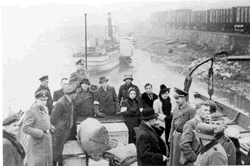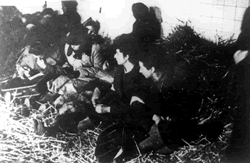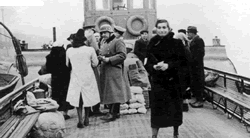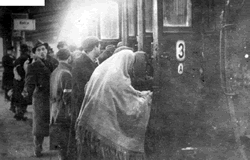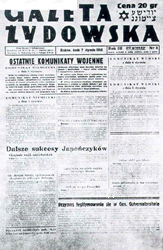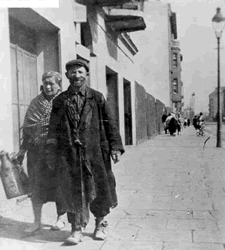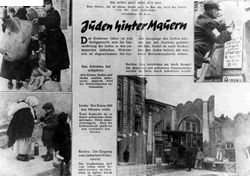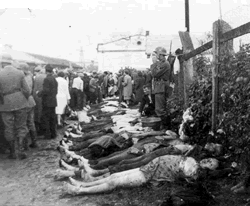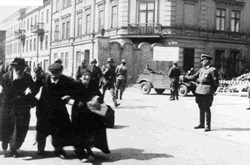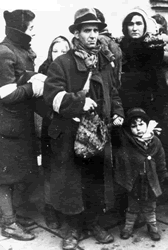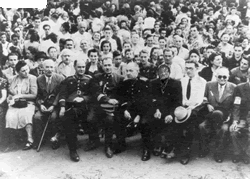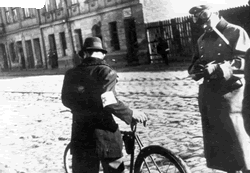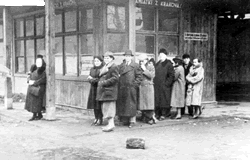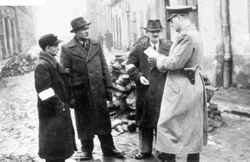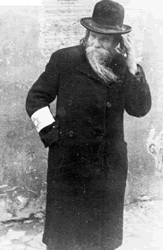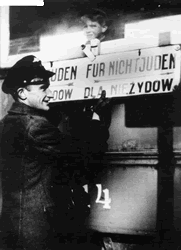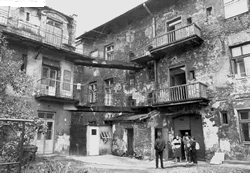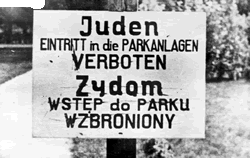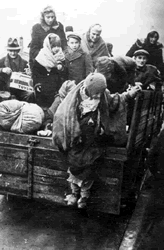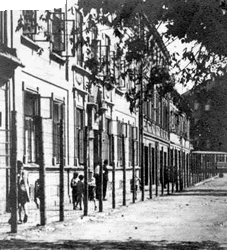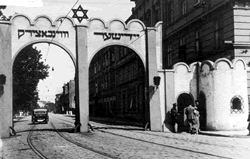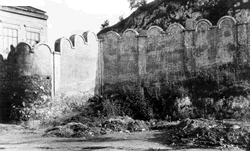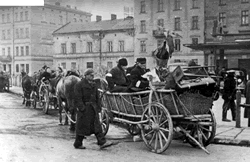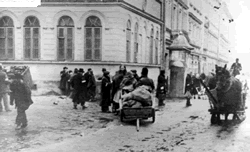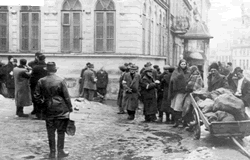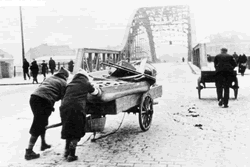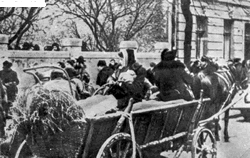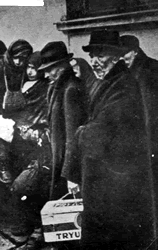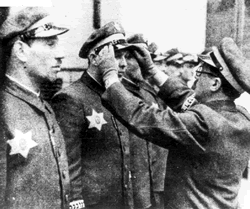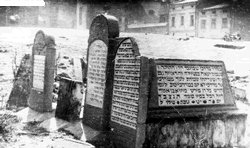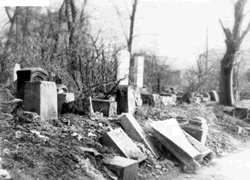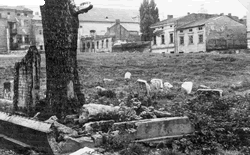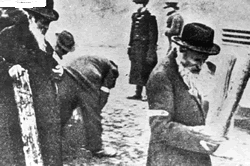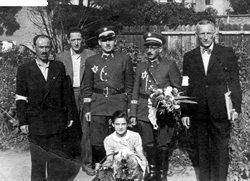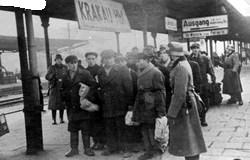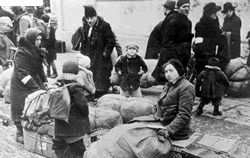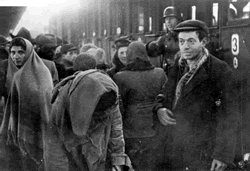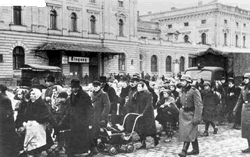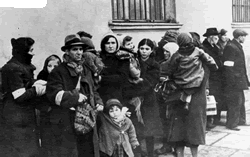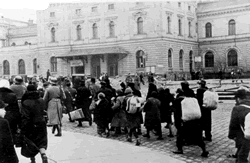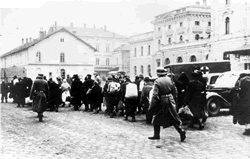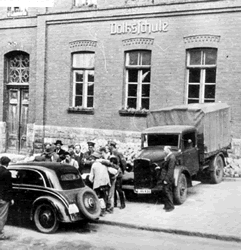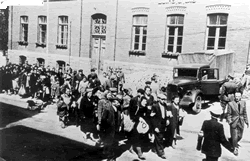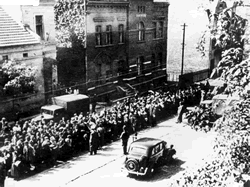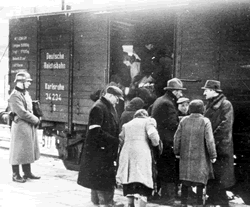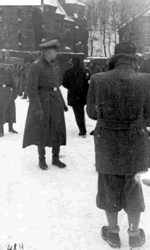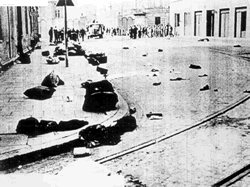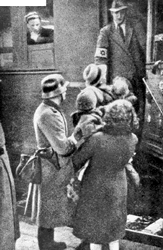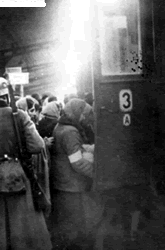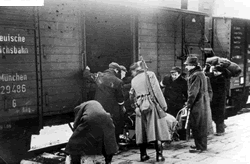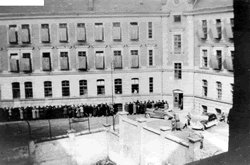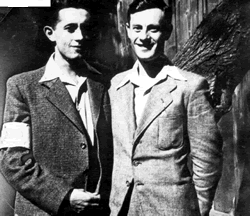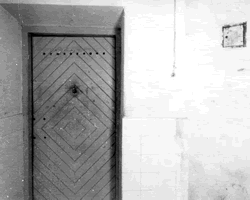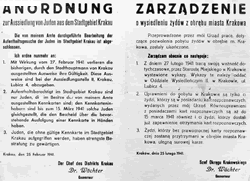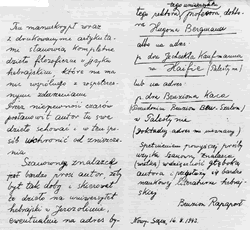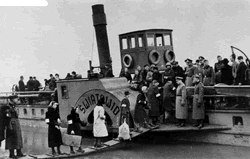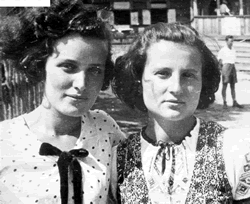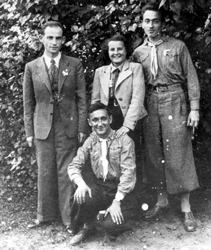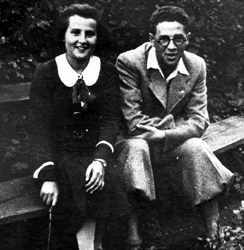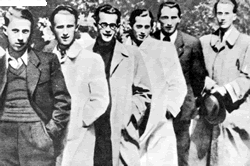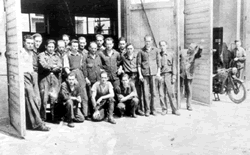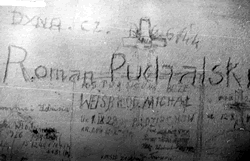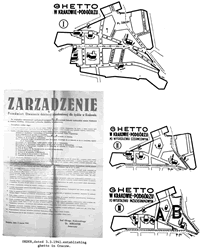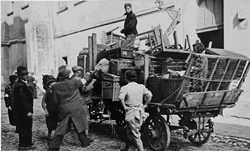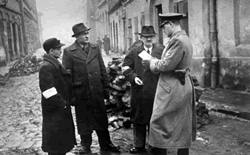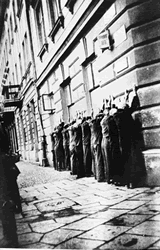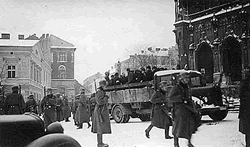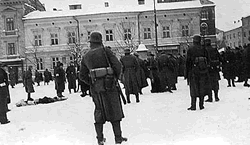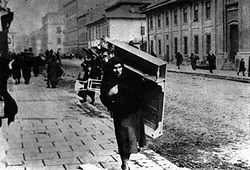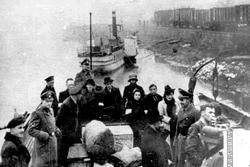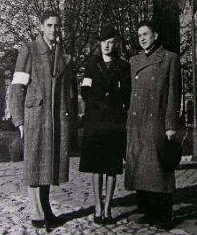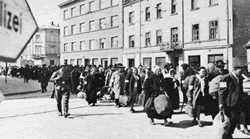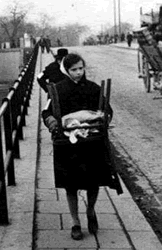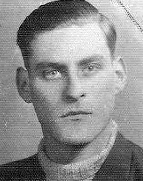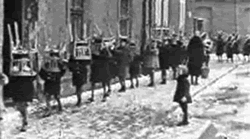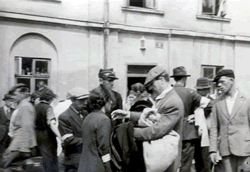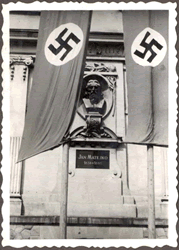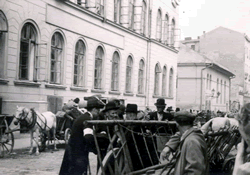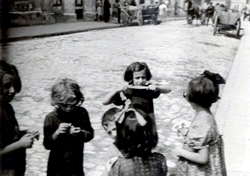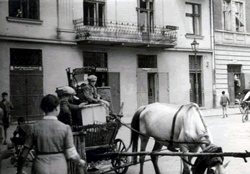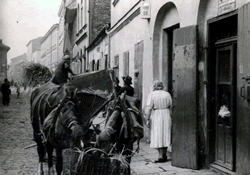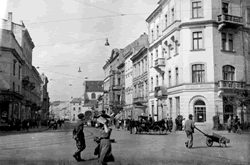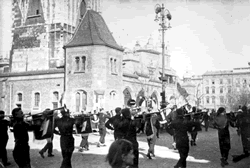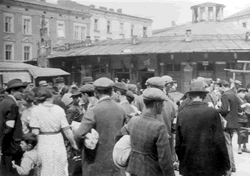|
#krkw_g-1: Jews being deported from Krakow, sailing on a boat with their bundles of belongings |
#krkw_g-2: Jews from the Krakow ghetto, assembled prior to their deportation, seated on piles of straw. |
|
#krkw_g-3: Jews being deported from Krakow, sailing on a boat on the Wisla River with their bundles of belongings. |
#krkw_g-4: Jews being deported from Krakow, boarding a passenger train. |
|
#krkw_g-5: The front page of the Polish - language newspaper "Gazeta Zydowska" (Jewish Gazette) from Jan. 7, 1942. The weekly "Jewish Gazette" was published in Krakow during a two - year period from July 1940 through July 1942. It was a propaganda organ of the German civil administration of the Generalgouvernement, and intended for distribution to Jews throughout that area. The editors were the Jews Zeifert and Grosman. |
#krkw_g-6: A Jewish couple on a street in the Krakow ghetto. The woman is holding a milk jug. The man has an armband on his right sleeve. Photographed, apparently, by a German soldier. |
|
#krkw_g-7: A Nazi propaganda poster explaining the "advantages" of surrounding the Krakow ghetto with a wall. The main title: "Jews Behind Walls." Four photographs portray a policeman checking a bag on a woman's back, a boy exchanging something with an elderly woman, a Jew posting a sign in Yiddish, and a streetcar passing through a gateway to the ghetto. The text above the title reads: "They should remain completely among themselves. A wall, under construction here, will keep the Jews out of the city." |
#krkw_g-8: A German soldier in the Krakow ghetto, standing beside the bodies of Jews laid out in a row. On the left, a column of Jews walks by, some looking to try and identify the dead |
|
#krkw_g-9: An elderly Jew at the entrance to a Jewish - owned confectionery and soda shop in the Krakow ghetto. He is wearing an armband. In the display window is a sign with the Star of David symbol, with the words "Jewish shop" in German and Polish under it. The shop's sign has another Star of David added to it. |
#krkw_g-10: German soldiers and an officer entering the Krakow ghetto. In the foreground are three elderly Jews, hurrying away from the soldiers. Part of the ghetto wall is seen behind the automobile. |
|
#krkw_g-11: A Jewish family prior to their deportation from the Krakow ghetto. Two of the people in the photograph have armbands. Photographed in 1943 |
#krkw_g-12: The audience at a performance in the Krakow ghetto. Three German officers are seated in the front row. The man seated on the right in the front row has an armband. |
|
#krkw_g-13: A German officer checking the documents of a Jew in the Krakow ghetto. The Jew, standing with his bicycle, is wearing an armband. |
#krkw_g-14: Jews waiting at a railroad station in Krakow. The two women on the left have armbands. |
|
#krkw_g-15: A German officer checking the documents of three Jews in the Krakow ghetto. Two of the Jews are wearing armbands. |
#krkw_g-16: An ultra - Orthodox Jew from the Krakow ghetto. He is wearing an armband. Photographed in 1943. Note: this is possibly a German propaganda photograph |
|
#krkw_g-17: A Krakow streetcar worker hanging a sign separating Jewish and non - Jewish passengers. The sign, in German and Polish, indicates with arrows that Jews go to the left, non - Jews to the right. |
#krkw_g-18: A house with an adjoining yard, in the area of the Krakow ghetto |
#krkw_g-19: A sign in a public park in Krakow: "Jews: Entry is Forbidden" written in German and Polish. |
#krkw_g-20: The deportation of Jews from the Krakow ghetto. |
#krkw_g-21: The barbed - wire fence on Boluslaw Limanowski Street, along the boundary of the Krakow ghetto. A streetcar is seen at the end of the street. This fence separated the "Aryan" side of the street from the Jewish side, between 1940 and 1943. |
#krkw_g-22: The entry gate to the Krakow ghetto. The lettering at the top, in Yiddish, reads "Jewish Residential Area" -- a direct translation of "Wohnbezirk," the German term for the ghetto |
#krkw_g-23: A section of the walls of the Krakow ghetto |
#krkw_g-24: |
#krkw_g-25: |
#krkw_g-26: |
#krkw_g-27: |
#krkw_g-28: |
#krkw_g-29: |
#krkw_g-30: A German propaganda photo showing a roll call of Jewish ghetto police in the Krakow ghetto. Three of them have yellow badges, and two are wearing armbands. The police chief Simcha Spiro - Szapiro is straightening a policeman's hat. The photo has the following caption in German: "A roll call of the Jewish Order Police. They display the Star of David insignia on the right side of their chests. Their job is to oversee movement in the streets, man barriers in areas infected with communicable diseases, and are responsible for maintaining and ensuring cleanliness in the ghetto. Note: "Order Police" (O.D. or Ordnungdienst) was the official German name for the Jewish ghetto police. |
#krkw_g-31: Smashed gravestones in the cemetery in Krakow named for 16th century Rabbi Moshe Isserles (known as the Rema, the acronym of his name). |
#krkw_g-32: Smashed and uprooted gravestones in the Jewish cemetery in Krakow |
#krkw_g-33: |
#krkw_g-34: Elderly Jews at forced labor in the Krakow ghetto |
#krkw_g-35: Jewish ghetto policemen and others in the Krakow ghetto. In the photo: Simcha Spiro - Shapira, head of the Jewish ghetto police force (second from the right). The two uniformed policemen are wearing police armbands and yellow badges. The two men standing on either side of the group are wearing armbands marked with a Star of David |
#krkw_g-36: A group of Jews from the Krakow ghetto at a railroad station in the city, prior to their deportation for forced labor. They are guarded by armed German soldiers. |
#krkw_g-37: Jews awaiting deportation from the Krakow ghetto, waiting with their bundles of belongings. Two of the Jews can be seen with armbands. Photograped in 1943. |
#krkw_g-38: Jews being deported from the Krakow ghetto, about to board the train. A German soldier stands in the entrance to a car. |
#krkw_g-39: Jews being deported from the Krakow ghetto, escorted by German soldiers. |
#krkw_g-40: |
#krkw_g-41: |
#krkw_g-42: |
#krkw_g-43: |
#krkw_g-44: |
#krkw_g-45: |
#krkw_g-46: |
#krkw_g-47: German military men prior to conducting a sweep to round up Jews in the Krakow ghetto. |
#krkw_g-48: The belongings of Jews, who were deported to the Belzec extermination camp, abandoned on a Krakow ghetto street. |
#krkw_g-49: A Jewish family being deported from the Krakow ghetto, boarding a passenger train |
#krkw_g-50: Jewish women being deported from the Krakow ghetto, boarding a train. |
#krkw_g-51: Jews being deported from Krakow, boarding a freight car with their belongings. |
#krkw_g-52: Prisoners in the inner yard of the Montelupich police prison in Krakow. German military men stand near the automobiles |
#krkw_g-53: Dolek Liebeskind and Shimshon Draenger, among the leaders of the Akiva movement and the Jewish underground in the Krakow ghetto |
#krkw_g-54: A cell in the Gestapo headquarters building at 2 Pomorska Street in Krakow |
#krkw_g-55: An ordinance regarding the "eviction" of the Jews from the area of the city of Krakow. This ordinance was signed by Dr. Wachter, governor of the Krakow district, and dated February 25, 1941. It was printed in German and Polish. According to the text: There would no longer be authorization for Jews to remain in the area of Krakow. As of February 27, 1941, all prior authorizations issued by the city government and held by Jews, would expire. These expired authorizations were to be turned in to the Deportation Department. Only those Jews holding special identity cards issued by the governor's office would be allowed to stay in the city, and those to whom those cards were to be issued. These last would be able to stay in Krakow until March 15, 1941. Severe punishment would be imposed on those found in the city without the proper permit |
#krkw_g-56: A photograph of a letter in Polish by Ben Zion Rapaport, researcher from Krakow, in which he asks the finder of his research papers to send them to the Hebrew University in Jerusalem. The letter, written in Nowy Sacz on August 16, 1942, reads: "The manuscript and the attached articles are an entire philosophical work in the Hebrew language, with no connection to current events. Due to the uncertainty of the times, the writer has decided to hide this work so as to save it from destruction. The kindly finder is asked to transfer it to the Hebrew University in Jerusalem, and if it is not possible to send it there, the writer is providing the names and addresses of the former rector, Professor S. H. Bergman, and of Dr. Yechezkel Koifman of Haifa, as well as the name of Dr. B. Z. Katz. The writer will be eternally grateful. This deed will bring about the furtherance of the study of Hebrew literature." |
#krkw_g-57: The deportation of Jews from Krakow to surrounding settlements, by boat on the Wisla (Vistula) River. There are several German military men on the boat. Krakow was named as capital of the Generalgouvernement, and the Governor - General Hans Frank wanted to reduce the number of city's Jews to a minimum. Beginning on August 15, 1941, the Jews were ordered to leave the city and not return. |
#krkw_g-58: Minka Liebeskind and Gusta Dawidson - Draenger, members of the Akiva movement and the Jewish underground in the Krakow ghetto. |
#krkw_g-59: Four members of the Akiva movement and the Jewish underground in the Krakow ghetto. In the photo: Edwin Weiss (standing, right), Minka Liebeskind (standing, center), Yehuda Tenenbaum (standing, left), and Chaim Kermisz (kneeling). |
#krkw_g-60: Minka Liebeskind and Benek - Baruch Weksner, members of the Akiva movement and the Jewish underground in the Krakow ghetto. Photographed in 1938 |
#krkw_g-61: Members of the Jewish underground in the Krakow ghetto. |
#krkw_g-62: Jewish inmates in the Montelupich prison in Krakow, who worked in the Gestapo's central garage on Konarski Street. Photographed in 1942 by a German SS driver. In the photo: Bobi Kahana (on the left), Rimek Meirovic, Friedlander, Feldman, Sloman, Kornhauzer, Rott, Izio Apel - Kapita, Moshe Eintracht, and Goldberg. The Polish garage mechanic, Tadeusz Kuzibau, is standing next to the motorcycle |
#krkw_g-63: Graffiti on the wall of Cell No. 2 in the Gestapo building at 2 Pomorska Street in Krakow. Among the writing, some names may be distinguished: Roman Puchalski, Michael Weisbrod, Dyna Cz. and others |
#krkw_g-64: Map of the ghetto |
#krkw_g-65: |
#krkw_g-66: |
#krkw_g-67: |
#krkw_g-68: A round-up of Jews in the Podgrski Market, Cracow. Photograph by Jzef Seweryn |
#krkw_g-69: A round-up of Jews in the Podgrski Market, Cracow. Photograph by Jzef Seweryn |
#krkw_g-70: The Kazimierz district, Krakowska Street. March 1941. Jews being taken to the ghetto in Podgrze district. |
#krkw_g-71: Krakow, Poland, Jews on a deportation steamer with German policemen and SS men. |
#krkw_g-72: |
#krkw_g-73: |
#krkw_g-74: |
#krkw_g-75: |
#krkw_g-76: |
#krkw_g-77: Trade in a ghetto street. |
#krkw_g-78: Nazi flags next to a bust of Jan Matejka. |
#krkw_g-79: Jews entering the ghetto with loaded wagons |
#krkw_g-80: young girls on a ghetto street |
#krkw_g-81: Krakow, Poland, Jews entering the ghetto with loaded wagons |
#krkw_g-82: Jews loading items onto a wagon to move to the ghetto |
#krkw_g-83: belongs to collection: Krakow, Poland, A private German album from the World War II period |
#krkw_g-84: outside the ghetto Krakow, Poland, "Volksdeut?sches Haus", a place of recreation for "Ethnic Germans". |
#krkw_g-85: A march of "Ethnic Germans" in the city center. |
#krkw_g-86: Jews in the street. |
#krkw_g-87: |
#krkw_g-88: |
#krkw_g-89: |
#krkw_g-90: |
#krkw_g-91: |
#krkw_g-92: |
#krkw_g-93: |
#krkw_g-94: |
#krkw_g-95: |
#krkw_g-96: |
